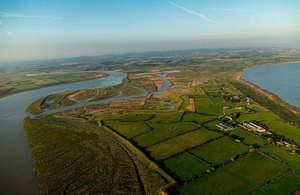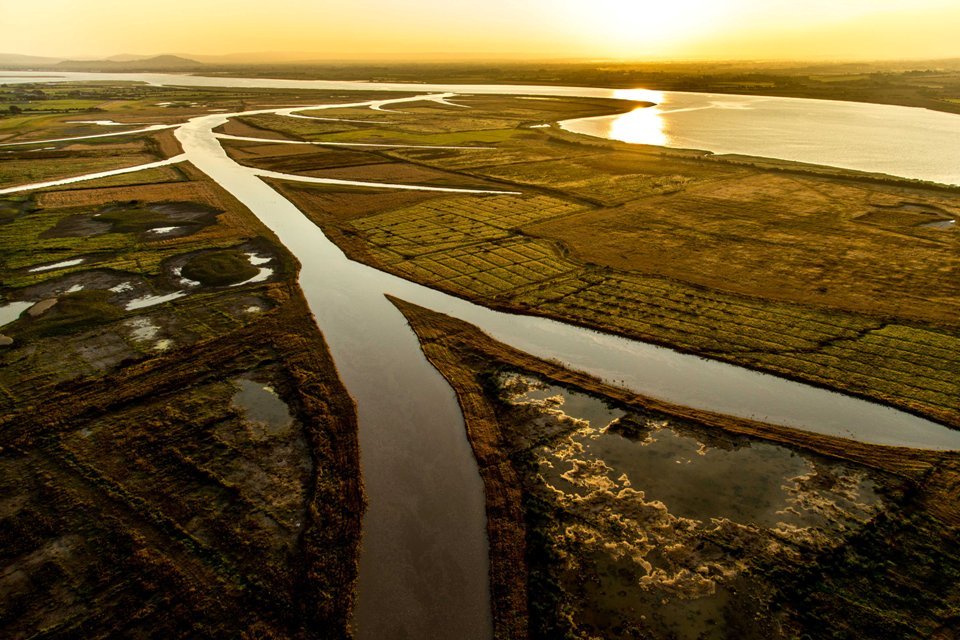Biggest coastal flood management scheme completed
UK’s biggest ever coastal realignment scheme at Steart, a joint project between WWT and Environment Agency, has been completed.

High tides enter the newly created Steart Marshes, 8 September 2014
The construction of Steart Marshes means the Environment Agency can continue its maintenance of flood risk schemes elsewhere in the Severn Estuary that protect 100,000 homes and businesses.
Rising sea levels are predicted to result in loss of inter-tidal habitat in the Severn Estuary. Steart Marshes will replace about half of this loss and reduce the flood risk for local communities. Just before 7am on Monday 8 September, high tides entered 250 hectares of low-lying land for the first time in centuries, through a newly excavated 200 metre gap in the Parrett Estuary coastal embankments.

Sunrise 8 September 2014 and the high tide enters the newly created Steart Marshes
People and property remain protected by newly constructed flood risk management scheme. Over the coming months and years salt-tolerant plants will colonise the area and form a new saltmarsh.
The Wildfowl & Wetlands Trust (WWT) and Environment Agency’s Steart Marshes scheme uses the shallow gradient and coarse vegetation of the saltmarsh to absorb wave energy naturally. This will help to protect local villages from storm surges, and protect the newly constructed flood banks from erosion so that they last longer.
WWT Chief Executive Martin Spray said:
We need to be brave and bold if we are going to deal with the impacts of climate change. WWT Steart Marshes proves you can protect homes and businesses by using wetland technology that works with nature, not against it.
Climate change is here now. Last winter was the wettest on record and we suffered the worst storms for 20 years. I want to give full credit to the villagers of the Steart Peninsula for getting behind this idea, helping to shape it and helping to save the peninsula from being lost to rising sea levels.
Richard Cox, for the Environment Agency, said:
Over 200km of coastal banks around the Severn Estuary reduce flood risk to more than 100,000 homes and businesses, a benefit valued at £5 billion. There is an ongoing need to maintain these structures.
The Steart project will directly protect homes, businesses and the surrounding infrastructure. The National Grid power lines into Hinkley Point power station are a key element of the national infrastructure protected by the scheme.
Saltmarsh is a natural flood risk management scheme. Like coral reefs or mangroves in the tropics, saltmarsh takes energy out of the tide and reduces wave height. At Steart Marshes the new flood embankments are set behind 100s of metres of saltmarsh which will reduce the impact of high tides on them, bringing down maintenance costs and prolonging their life.
Half a million cubic metres of soil were dug and moved to create new and improved flood banks.
The area is being managed as farmland and a nature reserve and in time the creek system should become a nursery for commercial fish stocks such as sea bass.
Steart Marshes has been carefully landscaped over the last two years and paths and bridleways have been created and improved to help more people enjoy the landscape. Local residents have played a key part in creating the scheme; several even took part in a sweep of the land before the seawater flowed in, to move any mammals or reptiles.
WWT plan to develop opportunities at Steart Marshes for young people to learn conservation and heritage skills that will lead to jobs in the South West.
Saltmarshes are part of Britain’s rich coastal heritage. It’s the landscape that inspired Charles Dickens’ “Great Expectations” and many paintings by JMW Turner.
As well as protecting the country from coastal flooding, and filtering pollution that would otherwise flow into the sea, saltmarshes are home to some of Britain’s most iconic wildlife – the Severn Estuary saltmarshes alone support more than 70,000 water birds.
Ends